Views: 0 Author: Site Editor Publish Time: 2025-08-08 Origin: Site










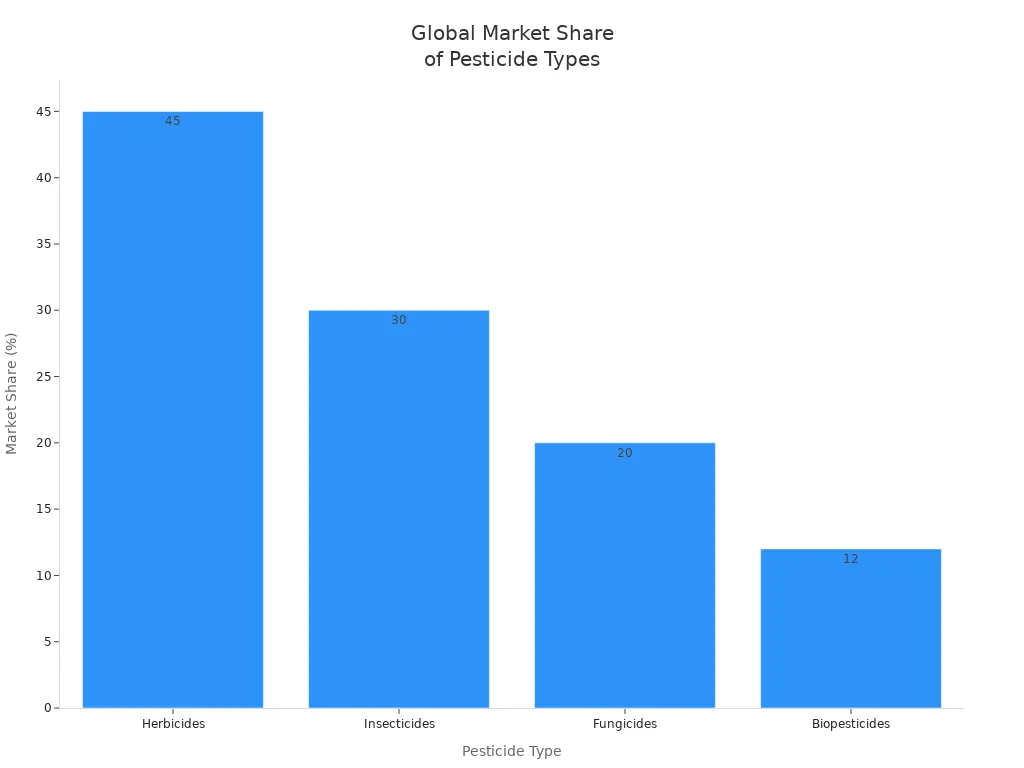
Pesticide Type | Global Market Share (Volume %) | Approximate Usage Volume (Metric Tons) | Regional Highlights |
|---|---|---|---|
Herbicides | Over 45% | ~1.8 million (2023) | North America: >500,000 tons each year; Common types: Glyphosate, Atrazine, 2,4-D |
Insecticides | About 30% | 1.2 million (2023) | Asia-Pacific: >40% used here; Main types: Pyrethroids, Neonicotinoids |
Fungicides | Around 20% | 800,000 (2023) | Latin America: 28% used here; Main types: Strobilurin, Triazole |
Biopesticides | 12% | >120,000 (2024, +18% YoY growth) | Europe & North America: >25% of products are biological |
Crop protection products play a crucial role in ensuring crop safety. Farmers have a wide range of crop protection products to choose from, and effective crop protection means understanding which products to use and how to apply them safely.
Farmers use many crop protection products. These include herbicides, insecticides, fungicides, and biopesticides. These products help protect crops from weeds, bugs, and diseases.
Herbicides are the most used crop protection product. They help control weeds. Weeds can lower crop yields by almost half if not managed.
Insecticides and fungicides keep crops safe from bad bugs and fungal diseases. Farmers must use them with care. This helps stop resistance and keeps good insects safe.
Biopesticides are a safer and more natural choice. They do not harm the environment as much. But they may work slower and can cost more money.
Farmers use both chemical and non-chemical methods. They follow safety rules and use products the right way. This helps them grow healthy crops and keep the environment safe.
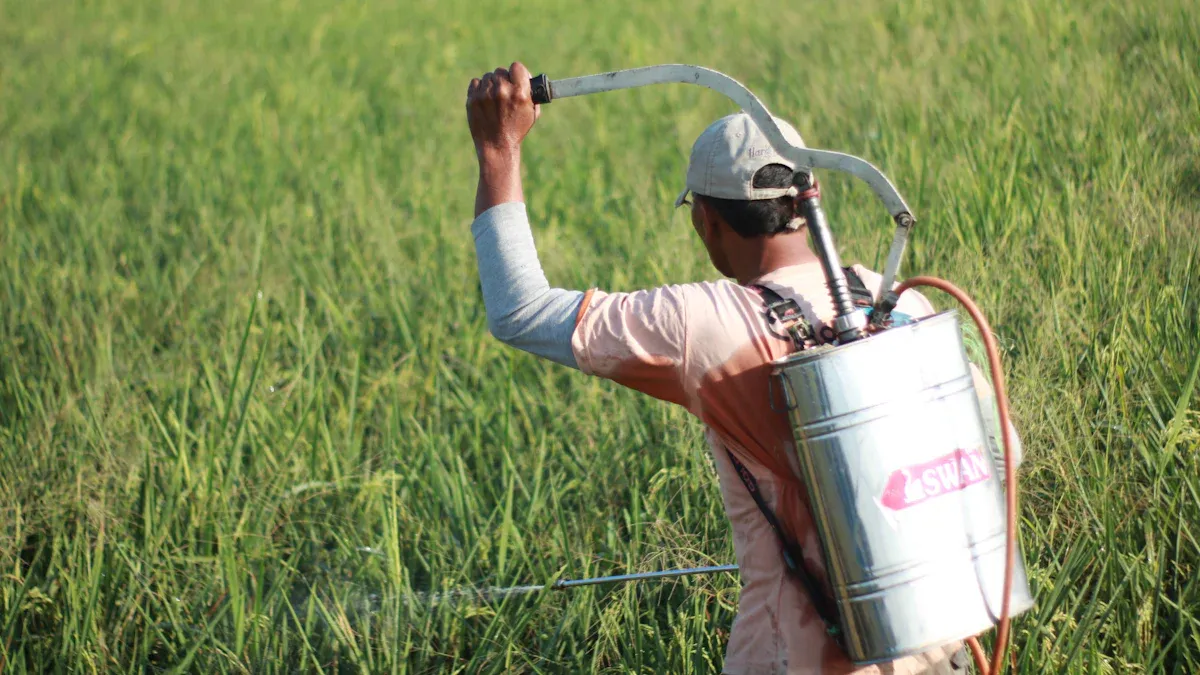
Modern farming uses several main crop protection products. These products help farmers fight weeds, bugs, and diseases. There are four main groups: herbicides, insecticides, fungicides, and biopesticides. Each group solves a different problem in the field. Farmers often mix these products for better results.
Herbicides help farmers get rid of weeds. Weeds take water, food, and sunlight from crops. If farmers do not control weeds, crops like corn and soybeans can lose about half their harvest. The table below shows how weeds hurt crop yields and cause money loss.
Crop | Yield Loss Without Weed Control | Economic Loss (USD) |
|---|---|---|
Corn | 52% | Part of $43 billion total in US and Canada |
Soybean | 49.5% | Part of $43 billion total in US and Canada |
Herbicides can save about 100 million metric tons of grain every year. Farmers pick different herbicides for different crops and weeds. Some common active ingredients are 2,4-D, atrazine, and glyphosate. 2,4-D works well on wheat and rice. Atrazine is popular but can get into groundwater. Glyphosate kills many weeds and is used with special crops.
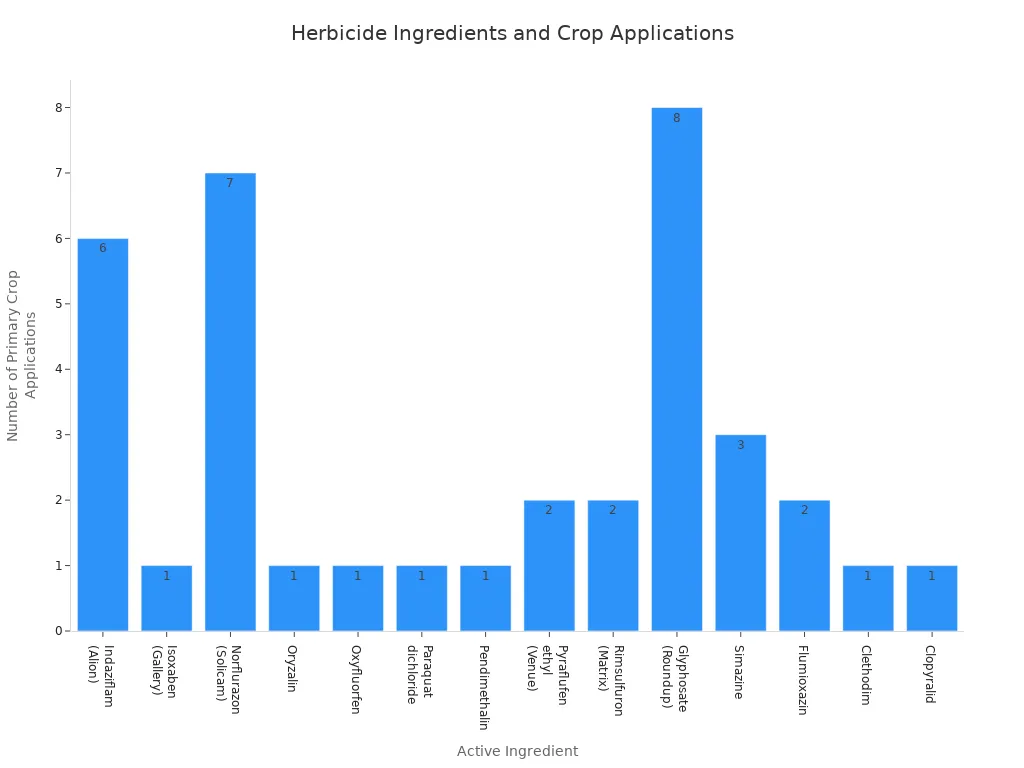
Farmers use pre-emergent and post-emergent herbicides. Pre-emergent types stop weeds before they grow. Post-emergent types kill weeds after they show up. Some herbicides only kill weeds, but others can harm any plant. Herbicide resistance is a big problem now. There are over 500 cases around the world. Because of this, farmers use more than one way to fight weeds.
Herbicides are the most used crop protection products. They help farmers kill weeds and save their crops.
Insecticides fight bugs that hurt crops. These bugs can eat leaves, stems, and roots. Bugs cause 20% to 40% of crop losses each year. Invasive bugs alone cost about $70 billion every year. Insecticides help lower these losses and keep food safe.
Farmers use insecticides as part of Integrated Pest Management. This plan uses chemicals, natural enemies, and farming tricks. Insecticides can kill bugs fast and stop big outbreaks. The table below lists main insecticide classes and how they work.
Insecticide Class | Mode of Action Description | Example Active Ingredients | Target Pests |
|---|---|---|---|
Carbamates | Acetylcholinesterase inhibitors | Carbaryl, Methomyl | Broad spectrum |
Organophosphates | Acetylcholinesterase inhibitors | Acephate, Chlorpyrifos, Malathion | Broad spectrum |
Pyrethroids | Sodium channel modulators (nerve poisons) | Bifenthrin, Permethrin, Deltamethrin | Broad spectrum |
Neonicotinoids | Nicotinic acetylcholine receptor modulators | Imidacloprid, Acetamiprid | Piercing-sucking insects, some beetles |
Sulfoximines | Same as neonicotinoids | Sulfoxaflor | Piercing-sucking insects |
Butenolides | Same as neonicotinoids | Flupyradifurone | Piercing-sucking insects, some thrips |
Spinosyns | Nicotinic acetylcholine receptor allosteric modulators | Spinosad, Spinetoram | Thrips, caterpillars, leafminers |
Avermectins | Glutamate-gated chloride channel allosteric modulators | Abamectin | Various pests including mites, nematodes |
Insect Growth Regulators | Juvenile hormone mimics or chitin synthesis inhibitors | Pyriproxyfen, Benzoylureas, Buprofezin | Whiteflies, scale insects, caterpillars |
Bacillus thuringiensis | Bacterial endotoxins disrupting insect gut lining | Bt kurstaki, Bt aizawai | Caterpillars, fungus gnats |
Spray adjuvants and oils help insecticides cover plants better. They also help control pests like mites and aphids. Farmers must be careful with insecticides. Too much can hurt good bugs and nature. Overuse can make bugs resistant. Still, insecticides are important for keeping crops safe.
Fungicides protect crops from fungal diseases. Fungi can attack leaves, stems, roots, and grains. Big crops like corn, soybean, wheat, and barley can lose a lot from fungi. Fungicides are needed when crops cannot fight diseases on their own.
Farmers use fungicides to stop diseases like Fusarium head blight, southern rust, and tar spot. These diseases can cause big losses. Fungicides work best with other crop protection methods. This includes using strong crop types, rotating crops, and checking fields often.
Fungicides work best with other crop protection tools.
Using too much can make fungi resistant.
Checking for resistance helps farmers use fungicides the right way.
The most used fungicides are dithiocarbamates, benzimidazoles, morpholines, triazoles, anilides, and strobilurins. Triazoles and strobilurins are very important for cereals, fruits, and vegetables. Crops like soybeans, grapes, bananas, and nuts also need fungicides.
Fungicides are important for crop protection. They help farmers fight diseases and save crops, but must be used carefully.
Biopesticides come from things like plants, bacteria, and fungi. They give farmers a natural way to protect crops. Farmers use biopesticides to fight pests, diseases, and weeds in a safer way.
Aspect | Biopesticides | Synthetic Pesticides |
|---|---|---|
Definition | Derived from natural living organisms (microorganisms, plants, animals); includes biochemical, microbial pesticides, and PIPs | Chemical-based pesticides synthesized artificially |
Usage Drivers | Increasing demand for organic food, stricter regulations on synthetics, consumer environmental awareness | Historically dominant due to fast and reliable pest control |
Efficacy | Generally slower and more variable; dependent on environmental factors; mode of action slower to manifest | Faster, more predictable, and reliable pest control |
Market Leadership | North America leads due to advanced agronomic practices, regulatory support, and organic demand | Widely used globally, especially in large-scale farming |
Challenges | Higher costs, limited shelf life, lack of farmer awareness, need for specific handling and timing | Environmental and health concerns leading to regulatory restrictions |
Adoption Rate | Growing but still lags behind synthetic pesticides due to slower action and cost factors | Higher usage rates but facing phase-out of some active ingredients due to environmental concerns |
Opportunities | Integration with precision agriculture technologies to improve application efficiency and reduce waste | Limited by regulatory bans and environmental impact concerns |
Biopesticides have some good points:
They leave little or no harmful leftovers.
They are safer for people and nature.
They can be used with other crop protection products.
But biopesticides also have some problems:
They may work slowly and need special conditions.
They often cost more and do not last as long.
Farmers need to learn more to use them well.
Biopesticides are becoming more popular, especially in North America and Europe. But farmers still use them less than synthetic pesticides. Many farmers use biopesticides with other crop protection methods.
Crop protection products like herbicides, insecticides, fungicides, and biopesticides are key for modern farming. Each type fights a certain threat and helps farmers save their crops.
Farmers use more than just the main crop protection products. They also need extra tools for special problems. These extra plant protection products help fill in the gaps. They support a full crop protection plan.
Acaricides are used to control mites. Mites can hurt many crops. Spider mites, like Tetranychus urticae, are a big problem. They attack vegetables, fruits, soybean, cotton, and corn. Farmers use acaricides to stop these pests.
Acaricides are important for managing mites.
Most acaricides are used on vegetables and fruits.
Soybean and corn now use more acaricides.
New chemicals and resistance plans keep acaricides working.
Acaricides are still needed, even with resistance.
These products help farmers stop mites before they lower yields.
Nematicides are used to fight nematodes. Nematodes are tiny worms that attack plant roots. They damage vegetables, grains, and other crops. Farmers use nematicides as fumigants or nonfumigants.
Nematode Genus | Common Crops Affected | Method of Attack | Symptoms/Impact on Crops |
|---|---|---|---|
Meloidogyne spp. | Tomato, carrot, celery, onion, sugar beet, soybean | Root penetration, root galls | Root galls, plant death, yield loss |
Heterodera spp. | Soybean, sugar beet, carrot, corn | Feed on root tissues | Stunted growth, wilting, poor yield |
Pratylenchus spp. | Wheat, canola, barley, chickpea | Feed on root tissues | Patchy decline, root necrosis |
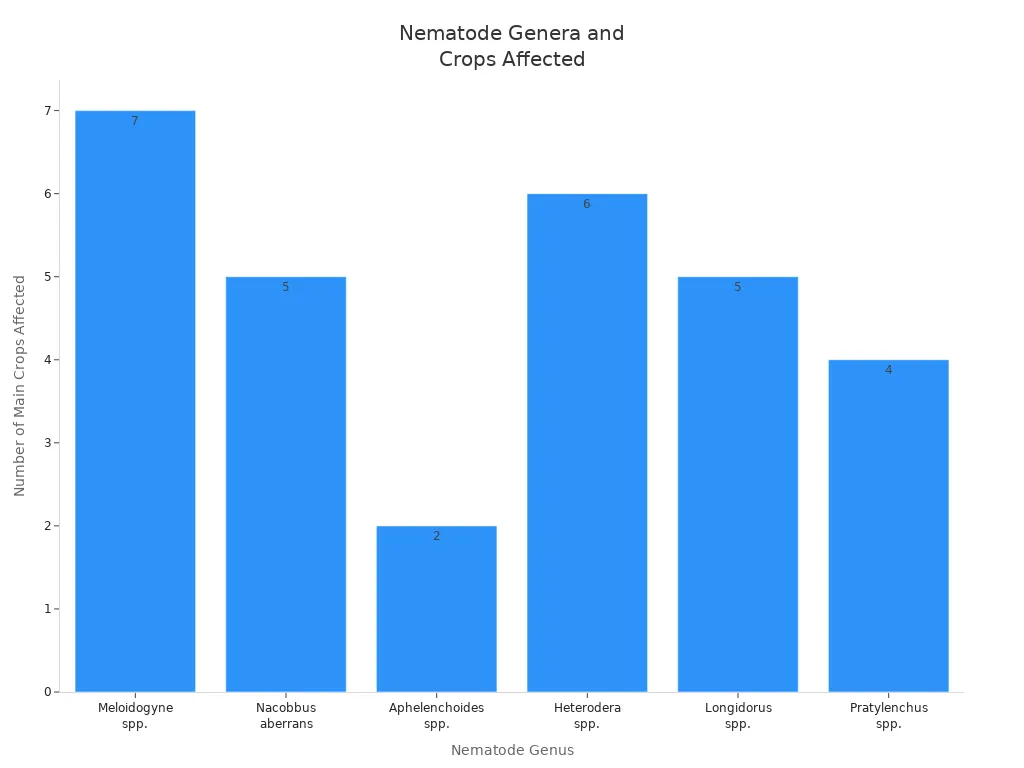
Nematicides protect crops like carrots and soybeans. These crops are very sensitive to nematode damage. Nematicides work best with other control methods.
Molluscicides are used to fight slugs and snails. These pests eat leaves and stems. They cause big losses in rice, corn, vegetables, and fruits. Molluscicides come as pellets or sprays.
Aspect | Evidence |
|---|---|
Economic impact | Golden apple snails can cut rice yields by up to 50% in Asia-Pacific. Slugs damage maize and soybean in the US. |
Molluscicide types | Metaldehyde and ferric phosphate are common. Pellets hold about 64% of the global market. |
Regional trends | Asia-Pacific uses the most molluscicides per hectare. Europe and South America also use a lot. |
Innovation | New products like niclosamide offer high efficiency and low toxicity. |
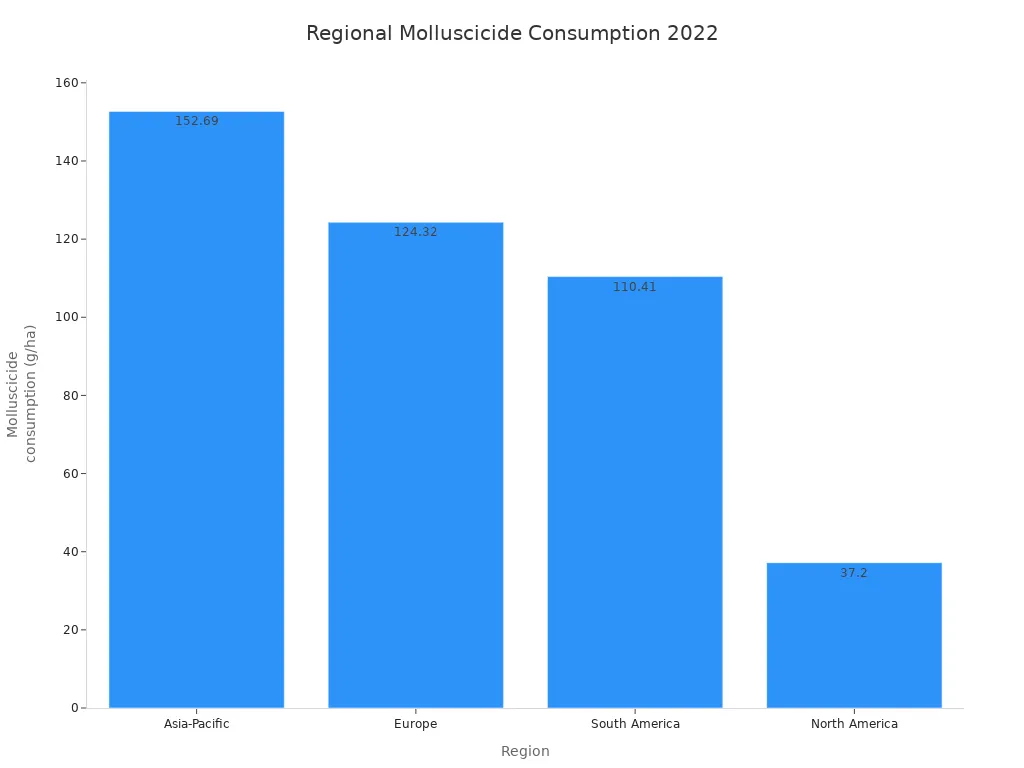
Farmers use molluscicides to protect their crops and food supply. These products help make farming more sustainable by lowering pest numbers.
Algicides are used to control algae. Algae can grow in irrigation systems, ponds, and rice fields. Algae block water flow and take nutrients from crops. Farmers use algicides to keep water clean and crops healthy. These products help in fields and greenhouses.
Plant growth regulators, or PGRs, help control how plants grow. They affect flowering and ripening. Farmers use PGRs to get bigger harvests and better quality.
PGRs help control growth and flowering.
Auxins and gibberellins help plants grow faster.
Cytokinins slow leaf aging and keep plants productive.
Gibberellin inhibitors keep plants short and strong.
PGRs help crops ripen at the same time.
These products help make farming more sustainable.
Defoliants are used to remove leaves from crops. Farmers use them to make harvesting easier and to control weeds.
Application Purpose | Defoliant Examples | Common Crops Used On |
|---|---|---|
Remove leaves for harvest | Pyraflufen ethyl, sodium chlorate, thidiazuron, tribufos | Cotton (Acala, Pima, Upland) |
Weed control and desiccation | Glyphosate, paraquat | Fruits, vegetables, nuts, corn, soybean |
Lawn and cropland management | 2,4-D, 2,4,5-T | Wheat, maize, rice, cereal grasses |
Defoliants are mostly used on cotton, wheat, maize, and rice. These products help farmers harvest quickly and control weeds.
These extra plant protection products work with main crop protection tools. They give farmers more ways to protect crops and get better yields.
Crop protection chemicals come in different forms. Farmers pick a type based on their crop and pest. They also think about the field and weather. The most common types are liquids and solids. Each type changes how the active ingredient works. It also changes how easy it is to use.
Wettable powders and soluble powders mix with water. They help the active ingredient spread out.
Emulsifiable concentrates mix with water and look milky. These help the active ingredient stick to plants.
Dry granules and water dispersible granules are simple to use. They let the active ingredient out slowly.
Some special types are gels, fumigants, smokers, aerosols, tablets, and baits. Gels are thick and cost more to make. Fumigants turn into gas and go deep in the soil. Smokers make fumes that fight pests.
The type of formulation changes how the active ingredient covers the plant. It also changes how long it lasts and how safe it is for nature. It affects how easy it is for farmers to use. The right type helps the active ingredient reach pests and work well.
Formulation Type | Example Use | Effect on Performance |
|---|---|---|
Wettable Powder | Fungicides, insecticides | Good coverage, easy mixing |
Emulsifiable Concentrate | Herbicides, insecticides | Strong sticking, even spread |
Granules | Soil-applied pesticides | Slow release, less drift |
Fumigant | Soil pest control | Deep penetration, high risk |
Adjuvants help crop protection chemicals work better. They help the active ingredient stick and spread on plants. They also help it get inside the plant. Adjuvants can make the active ingredient work up to 50% better. They help stop spray from blowing away. They make sure the active ingredient goes where it should.
Surfactants help the spray cover leaves well.
Oil-based adjuvants help the active ingredient get in faster.
Drift control agents stop the spray from drifting away.
Some adjuvants help the active ingredient work in bad weather.
Farmers must mix chemicals and adjuvants the right way. They should test if they work together before mixing. Stirring the mix keeps it smooth. Farmers should read the label and ask experts for help. Using the right adjuvant saves money and helps nature.
Tip: Always read the label to find the best adjuvant for each active ingredient. This helps you avoid problems and get the best results.
The right mix of chemicals, adjuvants, and pesticide ingredients gives farmers strong tools to keep crops healthy.
Farmers use many ways to keep crops safe. They mix chemical and non-chemical methods for better results. This helps stop pests from becoming resistant. It also helps protect the environment. Farmers only use insecticides, fungicides, and herbicides when needed. They check pest numbers before spraying. This is called Integrated Pest Management, or IPM. IPM uses action thresholds to decide when to treat. This helps farmers avoid spraying too much.
Crop rotation and growing different crops break pest cycles.
Good soil care and planting at the right time make crops stronger.
Farmers use barriers and traps to catch pests.
Natural enemies and biopesticides help keep pests in check.
Drones and sensors help farmers watch fields and spray only where needed.
Farmers also switch between different types of fungicides and insecticides. This slows down resistance. They look at fields before and after using products. They spray when pests are easiest to kill. These steps help crops and the environment.
Using many crop protection methods helps farmers grow more food. It also keeps farming safe for the future.
Non-chemical ways are important for crop protection today. Farmers use cultural, biological, and mechanical methods to fight pests. These include rotating crops, planting pest-resistant types, and cleaning up old plants. Barriers like nets and traps keep pests away.
Biological controls use helpful bugs, like ladybugs or wasps, to eat pests. Biopesticides come from nature and are safer than chemicals. Farmers also use repellents to keep pests away without hurting crops.
Non-chemical methods mean farmers use less insecticide and fungicide. This lowers resistance and saves good insects. These ways can take more work and time. But they help control pests for a long time and make fields healthier.
Non-Chemical Method | Example | Benefit |
|---|---|---|
Crop rotation | Corn-soybean rotation | Breaks pest cycles |
Physical barriers | Row covers, traps | Blocks or catches pests |
Biological control | Ladybugs, wasps | Lowers pest numbers |
Biopesticides | Bt, neem oil | Safer for people and animals |
Repellents | Garlic spray | Keeps pests away |
Non-chemical crop protection helps farmers grow healthy crops. It also helps take care of the environment.
Farmers and workers have to follow safety rules when using pesticides. They should always read the label before using any product. The label tells them which crops or pests it works on. It also shows how much to use. Wearing gloves, goggles, and long sleeves helps protect skin and eyes. People should not eat, drink, or smoke when handling pesticides. Mixing and spraying should be done outside or in a place with fresh air. This helps stop breathing in bad fumes.
Children, pets, and toys must stay away from sprayed fields until it is safe. After using pesticides, workers should wash their skin and change dirty clothes. Pesticides should be kept in their original bottles with childproof caps. Farmers need to lock these away from food and children. Empty bottles and spills must be cleaned up the right way to keep people and nature safe.
Safety Aspect | Key Guidelines |
|---|---|
PPE | Wear gloves, goggles, long sleeves, and boots. Clean and replace gear often. |
Application | Follow label steps. Do not spray on windy or rainy days. Only spray the right spot. |
Storage and Disposal | Keep in original bottles. Lock away from food and kids. Throw away waste safely. |
Emergency Preparedness | Have spill kits and first aid nearby. Know what to do in an emergency. |
Tip: Always write down when you use pesticides, what you used, and how much. This helps you follow the law and stay safe.
Pesticides can hurt the environment if not used right. Wind and rain can move chemicals into water, dirt, or other plants. Bees and butterflies can get sick from some products. Farmers can use traps and other ways to fight pests instead of chemicals. Removing pest hiding spots also helps use less pesticide.
Spraying only on calm, dry days keeps chemicals from drifting. Farmers should never use more than the label says or spray pests not listed. Leftover pesticides should be thrown away at special places to keep water and dirt clean. There are laws and rules, like USDA Organic and EPA, that tell farmers how to use pesticides safely. These rules help protect animals, workers, and people who live nearby.
Using pesticides the right way keeps crops, people, and nature safe. Following safety steps and rules helps everyone stay healthy.
Farmers use different crop protection products to stop weeds, bugs, fungi, and other problems. They also use extra tools like acaricides, nematicides, molluscicides, algicides, plant growth regulators, and defoliants to help even more.
Integrated Pest Management uses many ways to protect crops. It mixes biological, cultural, mechanical, and chemical methods for better results.
Cultural practices, careful chemical use, and new technology help keep crops safe.
Being responsible means checking for pests, changing products, and saving good insects.
Farmers can get the latest information from digital tools and USDA programs. These resources help them make good choices and keep crops healthy in the future.
Herbicides are used to kill weeds. Insecticides are used to kill insects. Farmers spray herbicides to stop weeds from growing. They use insecticides to keep bugs from eating crops.
Biopesticides come from things like plants or bacteria. They help farmers control pests and diseases. These products break down fast in nature. They are safer for people and the environment.
Crop protection products are safe if used the right way. Farmers read the label and wear safety gear. This keeps people, pets, and wild animals safe.
Adjuvants help chemicals stick better to plant leaves. They help the spray cover more of the plant. This makes the active ingredient work better. Farmers can use less product and still control pests.
Farmers use miticides to get rid of mites. They use rodenticides to control rats and mice. These products help protect crops from these pests.